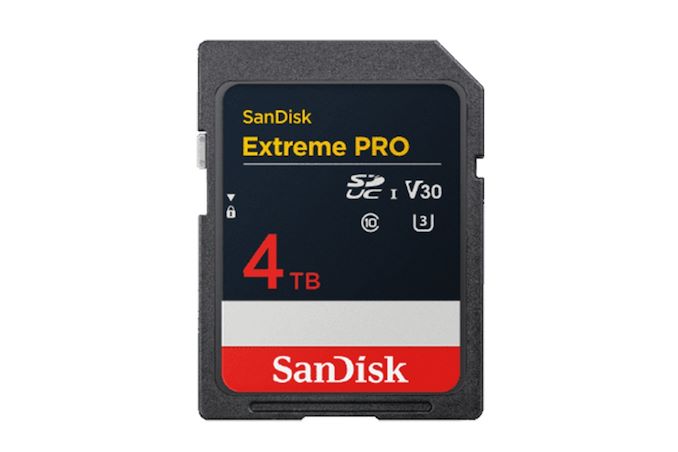Western Digital Previews 4 TB SD Card: World's Highest-Capacity
by Anton Shilov on April 11, 2024 6:30 PM EST- Posted in
- Storage
- Western Digital
- SanDisk
- SD cards
- SDUC

Western Digital this week is previewing the industry's first 4 TB SD card. The device is being showcased at the NAB trade show for broadcasters and content creators and will be released commercially in 2025.
Western Digital's SanDisk Extreme Pro SDUC 4 TB SD card complies with the Secure Digital Ultra Capacity standard (SDUC, which enables up to 128TB). The card uses the Ultra High Speed-I (UHS-I) interface and is rated for speed Class 10, therefore supporting a minimum speed of 10 MB/s and a maximum data transfer rate of 104 MB/s when working in UHS104 (SDR104) mode (there is a catch about performance, but more on that later). WD's SD card is also rated to meet Video Speed Class V30, supporting a minimal sequential write speed of 30 MB/s, which is believed to be good enough for 8K video recording, above and beyond the 4K video market that Western Digital is primarily aiming the forthcoming card at.
For now, Western Digital is not disclosing what NAND is in the SanDisk Extreme Pro SDUC 4 TB SD card. Given the high capacity and relatively distant 2025 release date, WD may be targetting this as one of their first products to use their forthcoming BiCS 9 NAND.
And while not listed in WD's official press release, we would be surprised if the forthcoming card didn't also support the off-spec DDR200/DDR208 mode, which allows for higher transfer rates than the UHS-I standard normally allows via double data rate signaling. Western Digital's current-generation SanDisk Extreme Pro SDXC 1 TB SD card already supports that mode, allowing it to reach read speeds as high as 170 MB/s, so it would be surprising to see the company drop it from newer products. That said, the catch with DDR208 remains the same as always: it's a proprietary mode that requires a compatible host to make use of.
Western Digital has not disclosed how much will its SanDisk Extreme Pro SDUC 4 TB SD card cost. A 1 TB SanDisk Extreme Pro card costs $140, so one can make guesses about the price of a 4 TB SD card that uses cutting-edge NAND.
Source: Western Digital










15 Comments
View All Comments
ballsystemlord - Thursday, April 11, 2024 - link
I'm kinda surprised it doesn't support A1 or A2 class random access speeds.Kamen Rider Blade - Thursday, April 11, 2024 - link
I wish it supported UHS III = 624 MB/s.It's "Fast Enough" w/o going into CF express territory.
The SD Card association needs to go with UHS III and give up on SD Express.
CF Express was purposely designed for PCIe, while SD Express is a kludge to say "Me too!".
It's really not necessary.
UHS III = 624 MB/s is FAST ENOUGH, then focus on capacity and cost effectiveness per GiB.
ballsystemlord - Friday, April 12, 2024 - link
Isn't V30 and UHS III the same thing?Hresna - Saturday, April 13, 2024 - link
No, V30 is a speed class specifically for video-capture and many v30 cards are only UHS-I, which is the physical interface. UHS-II has an extra row of pins enabling faster transfers. uHS-II cards also come in V60 and V90 speeds, the latter being niche and very niche and expensive. Most modern camera codecs would need v30 as a minimum for their most compressed “broadcast quality” codecs, and many will need cfexpress or ssd speeds. I’d be very surprised if you could shoot 8k on a v30 card and not have dropped frames connstantly.ballsystemlord - Monday, April 15, 2024 - link
Thanks!thomasjkenney - Friday, April 12, 2024 - link
This isn't a market I've watched recently, or much at all. I find it hilarious these devices have a mechanical write-protect toggle, just like a 3.5" floppy!CaptainBrowncoat - Saturday, April 13, 2024 - link
Considering SD cards (not the newer mini/mico/TF variants) have had them from the beginning - which overlaps in the timeline of common usage for floppy disks - they are merely following the spec. I don't know why you find it so amusing - they definitely have their uses for certain situations.Samus - Saturday, April 13, 2024 - link
Absolutely. I have a TrekStor USB3 external SSD that has a write-protect toggle, and purchased it just for that reason. I carry around a lot of warez\software cracks\etc and the read-only toggle prevents security software from removing "infected" files.PeachNCream - Tuesday, April 16, 2024 - link
I haven't heard someone use the word warez in well over a decade!Einy0 - Sunday, April 14, 2024 - link
I find it a bit paradoxical that most m.2 drives top out at 2TB, but in the near future you'll be able to buy a 4TB SD Card.